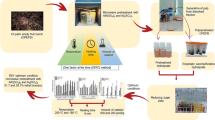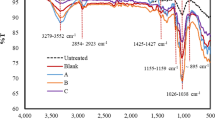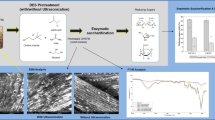Abstract
A biomass pretreatment utilizing biodegradable deep eutectic solvent (DES) incorporated into assistive heating techniques, would lead to an energy-efficient extraction. To achieve effective extraction yield while reducing the energy usage, lignin in oil palm empty fruit bunch (EFB) was extracted using DES with microwave heating and ultrasonic irradiation in the current study. The feasibility of lignin extraction using the heating methods in sequential order was examined ensued by optimization study with investigated parameters include water content in DES, irradiation duration, and heating method power. The best sequential ultrasonic irradiation—microwave heating (UMAE) resulted in delignification efficiency of 82.7% within 1 h. The yield is comparable with that using oil bath heating and same DES, but the latter involved 8 folds longer extraction time. The lignin obtained from this method is thermally stable (~ 356 °C decomposition temperature), with significant amount of phenolic compound and β–O–4 bonds (> 80%), implying that it has the potential for downstream modification. The mechanisms of delignification using DES-incorporated assistive heating methods were discussed. This study demonstrated that combining DES and UMAE in lignin extraction is simple and efficient, resulting in an 40% energy reduction and 90% decrease in pretreatment duration as compared to conventional method.
Graphical Abstract





Similar content being viewed by others
Data Availability
All data generated or analysed during this study are included in this published article.
References
Chen, Z., Bai, X.L.A., Wan, C.: High-solid lignocellulose processing enabled by natural deep eutectic solvent for lignin extraction and industrially relevant production of renewable chemicals. ACS Sustainable Chem. Eng., 6(9): 12205–12216 (2018). doi: https://doi.org/10.1021/acssuschemeng.8b02541
H. Xu et al.: Key process parameters for deep eutectic solvents pretreatment of lignocellulosic biomass materials: a review. Bioresource Technol., 310: 123416 (2020). doi: https://doi.org/10.1016/j.biortech.2020.123416
Karp, S.G., Woiciechowski, A.L., Soccol, V.T., Soccol, C.R.: Pretreatment strategies for delignification of sugarcane bagasse: a review. Braz. Arch. Biol. Technol. 56(4), 679–689 (2013). https://doi.org/10.1590/S1516-89132013000400019
Chen, Z., Reznicek, W.D., Wan, C.: Deep eutectic solvent pretreatment enabling full utilization of switchgrass. Biores. Technol. 263, 40–48 (2018). https://doi.org/10.1016/j.biortech.2018.04.058
Aghamohammadi, N., Reginald, S., Shamiri, A., Zinatizadeh, A., Wong, L., Nik Sulaiman, N.: An Investigation of sustainable power generation from oil palm biomass: a case study in Sarawak. Sustainability, 8(5): 416 (2016). doi: https://doi.org/10.3390/su8050416
Azadi, P., Inderwildi, O.R., Farnood, R., King, D.A.: Liquid fuels, hydrogen and chemicals from lignin: a critical review. Renew. Sustain. Energy Rev. 21, 506–523 (2013). https://doi.org/10.1016/j.rser.2012.12.022
Nations, U.: The 2030 agenda and the sustainable development goals: an opportunity for latin america and the caribbean (LC/G.2681-P/Rev.3) (2018)
Ragauskas, A.J., et al.: Lignin valorization: improving lignin processing in the biorefinery. Science 344(6185), 1246843–1246843 (2014). https://doi.org/10.1126/science.1246843
Rinaldi, R., et al.: Paving the way for lignin valorisation: recent advances in bioengineering, biorefining and catalysis. Angew. Chem. Int. Ed. 55(29), 8164–8215 (2016). https://doi.org/10.1002/anie.201510351
Renders, T., Van den Bosch, S., Koelewijn, S.-F., Schutyser, W., Sels, B.F.: Lignin-first biomass fractionation: the advent of active stabilisation strategies. Energy Environ. Sci. 10(7), 1551–1557 (2017). https://doi.org/10.1039/C7EE01298E
Sathitsuksanoh, N., et al.: Lignin fate and characterization during ionic liquid biomass pretreatment for renewable chemicals and fuels production. Green Chem. 16(3), 1236–1247 (2014). https://doi.org/10.1039/C3GC42295J
Balakshin, M., Capanema, E., Gracz, H., Chang, H., Jameel, H.: Quantification of lignin–carbohydrate linkages with high-resolution NMR spectroscopy. Planta 233(6), 1097–1110 (2011). https://doi.org/10.1007/s00425-011-1359-2
Cheng, J., Leu, S.-Y., Zhu, J.Y., Jeffries, T.W.: Ethanol production from non-detoxified whole slurry of sulfite-pretreated empty fruit bunches at a low cellulase loading. Biores. Technol. 164, 331–337 (2014). https://doi.org/10.1016/j.biortech.2014.04.102
Risdianto, H., Sugesty, S.: Pretreatment of Marasmius sp. on biopulping of oil palm empty fruit bunches. MAS, 9(7): 1 (2015). doi: https://doi.org/10.5539/mas.v9n7p1
Sabiha-Hanim, S., Noor, M.A.M., Rosma, A.: Effect of autohydrolysis and enzymatic treatment on oil palm (Elaeis guineensis Jacq.) frond fibres for xylose and xylooligosaccharides production. Biores. Technol. 102(2), 1234–1239 (2011). https://doi.org/10.1016/j.biortech.2010.08.017
Yang, B., Tao, L., Wyman, C.E.: Strengths, challenges, and opportunities for hydrothermal pretreatment in lignocellulosic biorefineries. Biofuels Bioprod. Bioref. 12(1), 125–138 (2018). https://doi.org/10.1002/bbb.1825
Jönsson, L.J., Martín, C.: Pretreatment of lignocellulose: formation of inhibitory by-products and strategies for minimizing their effects. Biores. Technol. 199, 103–112 (2016). https://doi.org/10.1016/j.biortech.2015.10.009
Rastogi, M., Shrivastava, S.: Recent advances in second generation bioethanol production: an insight to pretreatment, saccharification and fermentation processes. Renew. Sustain. Energy Rev. 80, 330–340 (2017). https://doi.org/10.1016/j.rser.2017.05.225
Abbott, AP., Capper, G., Davies, DL., Rasheed, RK., Tambyrajah, V.: Novel solvent properties of choline chloride/urea mixtures electronic. Chem. Commun. (2003). doi: https://doi.org/10.1039/b210714g
van Osch, D.J.G.P., Kollau, L.J.B.M., van den Bruinhorst, A., Asikainen, S., Rocha, M.A.A., Kroon, M.C.: Ionic liquids and deep eutectic solvents for lignocellulosic biomass fractionation. Phys. Chem. Chem. Phys. 19(4), 2636–2665 (2017). https://doi.org/10.1039/C6CP07499E
Tan, Y.T., Ngoh, G.C., Chua, A.S.M.: Evaluation of fractionation and delignification efficiencies of deep eutectic solvents on oil palm empty fruit bunch. Ind. Crops Prod. 123, 271–277 (2018). https://doi.org/10.1016/j.indcrop.2018.06.091
Adepu, K., Shah, E., Patel, A., Sharma, S., Dixit, G.: Physico-chemical characterization and evaluation of neat and aqueous mixtures of choline chloride + lactic acid for lignocellulosic biomass fractionation, enzymatic hydrolysis and fermentation. J. Mol. Liq. 271, 540–549 (2018). https://doi.org/10.1016/j.molliq.2018.09.032
Long, C., et al.: A novel deep eutectic solvent from lignin-derived acids for improving the enzymatic digestibility of herbal residues from cellulose. Cellulose 26(3), 1947–1959 (2019). https://doi.org/10.1007/s10570-018-2190-8
Tan, Y.T., Ngoh, G.C., Chua, A.S.M.: Effect of functional groups in acid constituent of deep eutectic solvent for extraction of reactive lignin. Biores. Technol. 281, 359–366 (2019). https://doi.org/10.1016/j.biortech.2019.02.010
Liu, Y., et al.: Enhanced enzymatic hydrolysis and lignin extraction of wheat straw by triethylbenzyl ammonium chloride/lactic acid-based deep eutectic solvent pretreatment. ACS Omega 4(22), 19829–19839 (2019). https://doi.org/10.1021/acsomega.9b02709
Sindhu, R., Silviya, N., Binod, P., Pandey, A.: Pentose-rich hydrolysate from acid pretreated rice straw as a carbon source for the production of poly-3-hydroxybutyrate. Biochem. Eng. J. 78, 67–72 (2013). https://doi.org/10.1016/j.bej.2012.12.015
Yan, D., et al.: Multimode-ultrasound and microwave assisted natural ternary deep eutectic solvent sequential pretreatments for corn straw biomass deconstruction under mild conditions. Ultrasonics Sonochem., 72: 105414 (2021). doi: https://doi.org/10.1016/j.ultsonch.2020.105414
Sluiter, A., et al.: Determination of structural carbohydrates and lignin in biomass. In: Laboratory Analytical Procedure (LAP). National Renewable Energy Laboratory, pp. 1–18 (2012)
Wu, C.-F., Hamada, M.: Experiments: planning, analysis, and optimization, 2nd edn. Wiley, Hoboken (2009)
Jun, H., Xiao, R., Shen, D., Zhang, H.: Structural analysis of lignin residue from black liquor and its thermal performance in thermogravimetric-Fourier transform infrared spectroscopy. Biores. Technol. 128, 633–639 (2013). https://doi.org/10.1016/j.biortech.2012.10.148
Myers, R.H., Montgomery, D.C., Anderson-Cook, C.M.: Response surface methodology: process and product optimization using designed experiments, 4th edn. Wiley, Hoboken (2016)
V. Z. Ong, T. Y. Wu, C. B. T. L. Lee, N. W. R. Cheong, and K. P. Y. Shak, (2019) Sequential ultrasonication and deep eutectic solvent pretreatment to remove lignin and recover xylose from oil palm fronds. Ultrasonics Sonochem., 58: 104598, doi: https://doi.org/10.1016/j.ultsonch.2019.05.015
Q. Ji, X. Yu, A. E.-G. A. Yagoub, L. Chen, and C. Zhou, (2020) Efficient removal of lignin from vegetable wastes by ultrasonic and microwave-assisted treatment with ternary deep eutectic solvent. Ind. Crops Prod., 149: 112357, doi: https://doi.org/10.1016/j.indcrop.2020.112357
Malaeke, H., Housaindokht, M.R., Monhemi, H., Izadyar, M.: Deep eutectic solvent as an efficient molecular liquid for lignin solubilization and wood delignification. J. Mol. Liq. 263, 193–199 (2018). https://doi.org/10.1016/j.molliq.2018.05.001
Ma, J., Ji, Z., Chen, J.C., Zhou, X., Kim, Y.S., Xu, F.: The mechanism of xylans removal during hydrothermal pretreatment of poplar fibers investigated by immunogold labeling. Planta 242(1), 327–337 (2015). https://doi.org/10.1007/s00425-015-2313-5
Jablonsky, M., Haz, A., Majova, V.: Assessing the opportunities for applying deep eutectic solvents for fractionation of beech wood and wheat straw. Cellulose 26(13–14), 7675–7684 (2019). https://doi.org/10.1007/s10570-019-02629-0
Ninomiya, K., et al.: Ionic liquid/ultrasound pretreatment and in situ enzymatic saccharification of bagasse using biocompatible cholinium ionic liquid. Biores. Technol. 176, 169–174 (2015). https://doi.org/10.1016/j.biortech.2014.11.038
Narendra, K., Muley, P.D., Boldor, D., Coty, G.G., Lynam, J.G.: Pretreatment of waste biomass in deep eutectic solvents: conductive heating versus microwave heating. Ind. Crops Prod., 142: 111865 (2019). doi: https://doi.org/10.1016/j.indcrop.2019.111865
Hou, X.-D., Lin, K.-P., Li, A.-L., Yang, L.-M., Fu, M.-H.: Effect of constituents molar ratios of deep eutectic solvents on rice straw fractionation efficiency and the micro-mechanism investigation. Ind. Crops Prod. 120, 322–329 (2018). https://doi.org/10.1016/j.indcrop.2018.04.076
Aguilar-Reynosa, A., Romaní, A., Rodríguez-Jasso, Ma.R., Aguilar, C.N., Garrote, G., Ruiz, H. A.: Microwave heating processing as alternative of pretreatment in second-generation biorefinery: an overview. Energy Conv. Manag., 136: 50–65 (2017). doi:https://doi.org/10.1016/j.enconman.2017.01.004
Mohtar, S.S., et al.: Extraction and characterization of lignin from oil palm biomass via ionic liquid dissolution and non-toxic aluminium potassium sulfate dodecahydrate precipitation processes. Biores. Technol. 192, 212–218 (2015). https://doi.org/10.1016/j.biortech.2015.05.029
Halder, P., Kundu, S., Patel, S., Marzbali, M.H., Parthasarathy, R., Shah, K.: Investigation of reaction mechanism and the effects of process parameters on ionic liquid-based delignification of sugarcane straw. Bioenerg. Res. 13(4), 1144–1158 (2020). https://doi.org/10.1007/s12155-020-10134-7
Wen, J.-L., Sun, S.-L., Xue, B.-L., Sun, R.-C.: Recent advances in characterization of lignin polymer by solution-state nuclear magnetic resonance (NMR) methodology. Materials 6(1), 359–391 (2013). https://doi.org/10.3390/ma6010359
Huang, J., Wu, S., Cheng, H., Lei, M., Liang, J., Tong, H.: Theoretical study of bond dissociation energies for lignin model compounds. J. Fuel Chem. Technol. 43(4), 429–436 (2015). https://doi.org/10.1016/S1872-5813(15)30011-6
Boerjan, W., Ralph, J., Baucher, M.: Lignin biosynthesis. Annu. Rev. Plant Biol. 54(1), 519–546 (2003). https://doi.org/10.1146/annurev.arplant.54.031902.134938
Author information
Authors and Affiliations
Contributions
YT: conceptualization, investigation, writing—original draft. ASM: conceptualization, visualization, resources, supervision. GC: conceptualization, writing—review & editing, resources, funding acquisition, project administration, supervision.
Corresponding author
Ethics declarations
Conflict of interests
The authors declare that they have no known competing financial interests.
Ethical Approval
The present material has not been published, simultaneously submitted, or accepted elsewhere, and it has been approved by the co-authors.
Additional information
Publisher's Note
Springer Nature remains neutral with regard to jurisdictional claims in published maps and institutional affiliations.
Supplementary Information
Below is the link to the electronic supplementary material.
Rights and permissions
Springer Nature or its licensor (e.g. a society or other partner) holds exclusive rights to this article under a publishing agreement with the author(s) or other rightsholder(s); author self-archiving of the accepted manuscript version of this article is solely governed by the terms of such publishing agreement and applicable law.
About this article
Cite this article
Cheong, Y.T., Chua, A.S.M. & Ngoh, G.C. Strategizing Assistive Heating Techniques on Delignification of Empty Fruit Bunch with Incorporation of Deep Eutectic Solvent. Waste Biomass Valor 14, 2801–2814 (2023). https://doi.org/10.1007/s12649-023-02079-7
Received:
Accepted:
Published:
Issue Date:
DOI: https://doi.org/10.1007/s12649-023-02079-7




